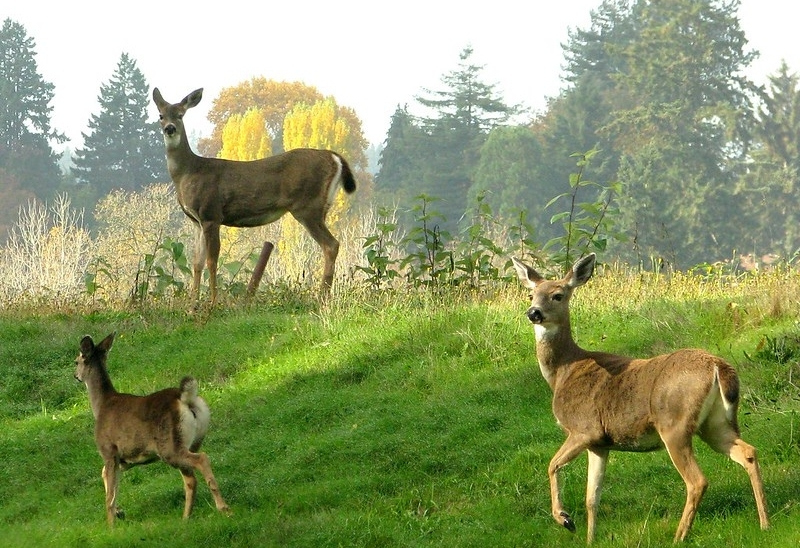Image courtesy of Noel Zia Lee on Flickr
How do you pick which crops to plant in your food plots each year? Many hunters say they grow the same mix year after year in the same location because “it works” and “the deer like it.” While that may be true, the better question is, “Does your soil like it?”
Your choice of forage to plant should satisfy your deer herd’s health but also your soil’s. Remember from our “Soil Management For Healthy Herds” article that animal nutrition and soil health are connected. For a plant to absorb nutrients, the nutrients must first exist in the soil! A well-planned crop rotation is a wise way to accomplish both management goals.
Crop Rotation Simplified
Crop rotation may seem complicated because there are so many crops to consider. First, remember that there are two forage crop seasons: cool-season and warm-season. And within each season, there are two crop lifecycles: annual and perennial. Each provides unique benefits at different times or in different ways.
You can plant any crop individually, but a mix can often give you the best of multiple worlds. Let’s take a closer look at the menu options you can offer.
Cool-Season Crops
Cool-season crops are relatively cold-hardy, meaning they can withstand at least some frost. They are generally planted in the fall, grow through the winter months, and mature in the spring. Brassicas, clovers, alfalfa, and many cereals and grasses are all cool-season crops.
Cool-season crops are generally easy to grow because there is less weed and pest pressure, plus adequate moisture is usually available to germinate seed and support plant growth. These crops often yield higher than warm-season crops because of their chunky roots or dense stands.
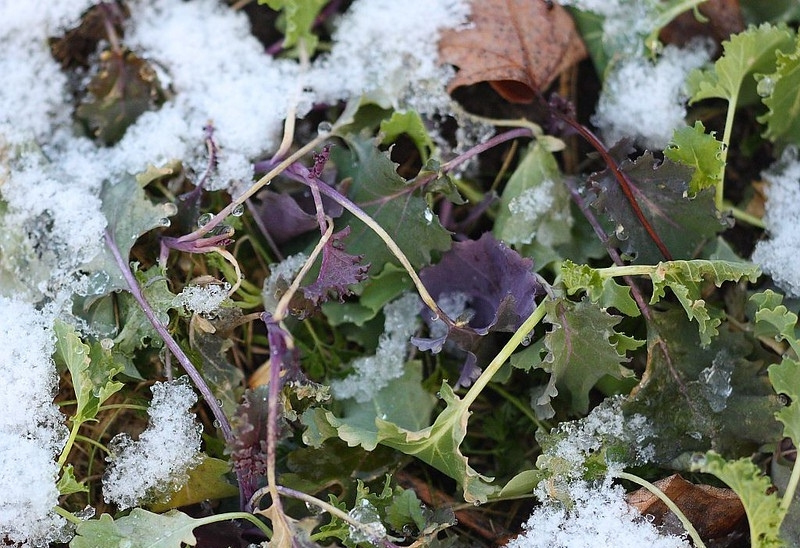 Image courtesy of deedavee easyflow on Flickr
Image courtesy of deedavee easyflow on Flickr
Warm-Season Crops
Warm-season crops are tender and killed by any frost. Plant them after all danger of frost has passed in spring. They grow throughout spring and generally produce in summer. Because of intense competition from weeds, pests, and disease, warm-season plots are more challenging to develop, even in areas with higher rainfall.
Soybeans, corn, sunflowers, cowpeas, lablab, sun hemp, and grain sorghum are warm-season crops. There are also valuable native grasses that provide perennial forage, but they generally produce less tonnage.
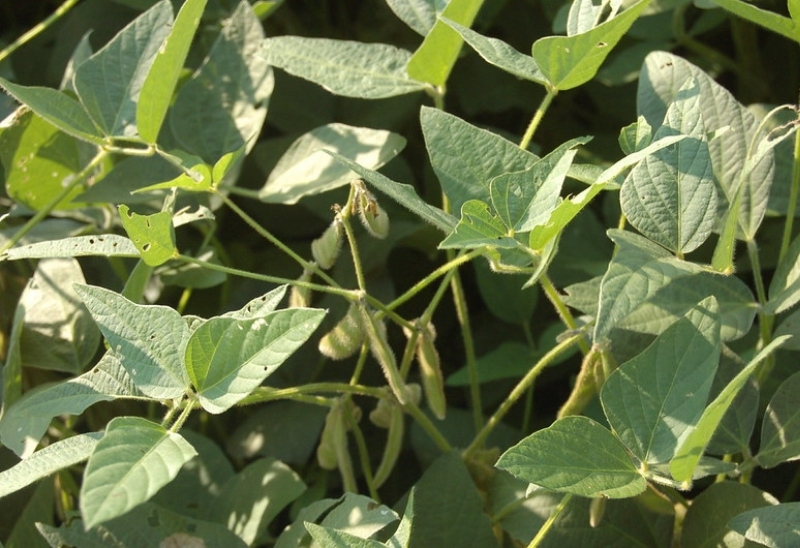 Image courtesy of the University of Delaware Carvel on Flickr
Image courtesy of the University of Delaware Carvel on Flickr
Annual vs. Perennial Crops
Within each crop season, there are also two crop life cycles. Annual crops are planted, grown, and harvested in a single season. They require planting each year but generally reward you with higher output. A few may even produce seed and sporadically resow themselves for next season. Soybeans, brassicas, and most cereal crops are annuals.
Perennial forages come back year after year from their roots -- without replanting. But they usually take longer to establish and produce limited quantities. Perennials are often considered a 'baseline' forage to supplement with higher producing annuals. Native grasses and many clovers are reliable perennial forages.
Which Crops Should You Plant In Your Food Plots?
A good wildlife manager’s goal is to utilize your property (specifically the soil) to provide deer with optimum food, cover, and bedding sources. Not all plants are edible nor desirable to deer. Some plants offer cover or meet the needs of other wildlife. So, what should you plant in your food plots?
Let’s use what we learned about nutrient digestibility from our last article, “Year-Round Nutrition Management,” to compare TDN (Total Digestible Nutrients) and ADF (Acid Detergent Fiber) on crops we commonly plant for deer:
Winter Wheat: 17% crude protein, 54% TDN, and an ADF of 30.
Soybeans: 44% crude protein (depending), 52% TDN, and an ADF of 36.
Clovers: 24% crude protein, 61% TDN, and an ADF of 23.
Brassicas: 36% crude protein, 82% TDN, and an ADF of 13.
Deer eat all of these crop species, but each provides different benefits. Dietary diversity is essential for many reasons, but this comparison shows why brassicas are hard to beat in your food plots. There are many misconceptions about protein. Deer do perfectly well with protein levels around 17-18%. It's only during their first year that deer need higher protein levels, which initially come from a doe's milk.
Brassicas
Brassicas have both excellent nutrient levels and digestibility, so the deer can readily utilize the maximum benefit. Many varieties form chubby roots that are useful for breaking up tough soil. Brassicas’ cold hardiness makes them a persistent producer even with snow on the ground. The stored sugar in their bulbous roots are a tasty treat when other crops have faded. You’ll often see hoof marks from where deer have dug them up from frozen ground!
- Not all brassicas are grown for their roots. Forage brassicas, rape, and swiss chard put their energy into lush leafy growth - like the collards and kale we eat (or should be eating).
- Turnips, radishes, rutabaga, and beets are excellent root crops that mine nutrients from deep in the soil and store sugars in cold temperatures.
- Don’t feel like you have to choose! A mix of brassicas can provide the benefits of both top leafy browse and longer term root crops.
Cereals
Cereal grains are deer magnets. These crops can act as a great cover crop for soil health and have high digestibility for deer. As a bonus, many cereal crops offer higher phosphorus doses than other forages (Remember from our last article how important phosphorus is?)
- Oats are always a deer favorite. They are highly digestible and contain more water than other cereals.
- Winter wheat is another great cereal choice and often succeeds in colder temperatures that stunt oats.
- Titricale and cereal rye are less palatable to deer and generally require sandy soils to perform their best. If you are planting a plot to hunt over, check the maturity dates and your hunting season. They may come on too early to be useful.
Legumes
Clovers, alfalfa, peas, and beans are useful legumes for any food plot, and there's one for every season. All legumes are high in calcium, making them excellent choices for combined plantings with cereal grains. Alfalfa may be the king of deer forage, but it is also the most difficult to grow, requiring extremely strict soil and moisture conditions. Get your feet wet with easier crops before venturing on to alfalfa, if your location and soil conditions permit it at all.
For a one-stop reference and detailed crop descriptions for all of our Deer Creek Seed options, download our 28-page 2021 Seed Guide.
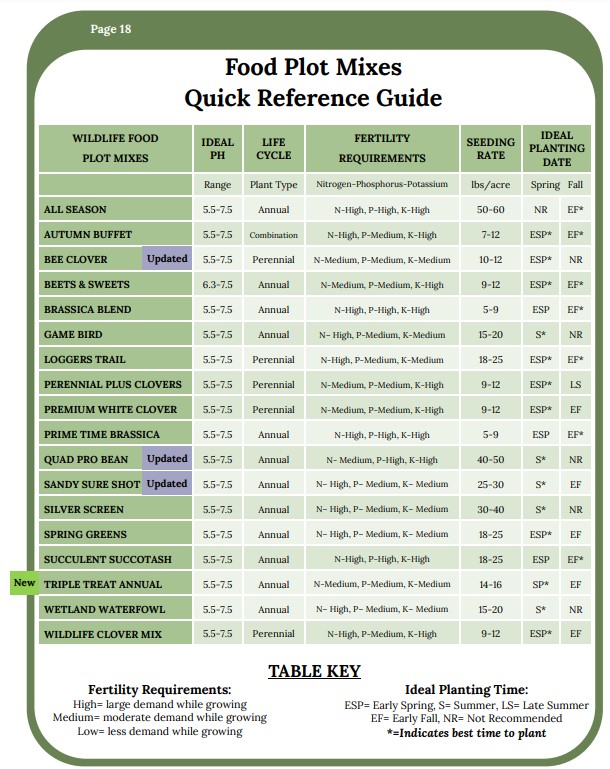
Why Crop Rotation Matters in Food Plots
So, what is crop rotation anyway? In basic terms, crop rotation is not planting the same crop or mixes year after year. Experienced growers rotate crops on a three-year basis.
Crop rotation plays two valuable roles: avoiding problems and reducing inputs/expenses. A little upfront planning provides both significant benefits.
Crop Rotation Prevents Problems
Growing the same crop in the same location for multiple years invites trouble, not deer -- namely pests and disease. Many of these troublemakers depend on a specific crop species. If you continue to provide the crop every season, you are fueling the problem. Common diseases and pests overwinter on crop residue and accumulate in the soil. Planting a different crop species disrupts the cycle and reduces the need for control methods - meaning less work for you just by differing your crop choice.
Insects and diseases live in the residue left behind from the previous crop and often aren't immediately apparent. So don't wait for signs of trouble to start rotating crops. Plan it now. Some accumulating diseases can persist in soils for decades, preventing any successful crop in the species (like brassicas). With good record keeping and intentional rotation, you can avoid the bulk of these problems. Crop rotation is the cheapest pest management you'll find!
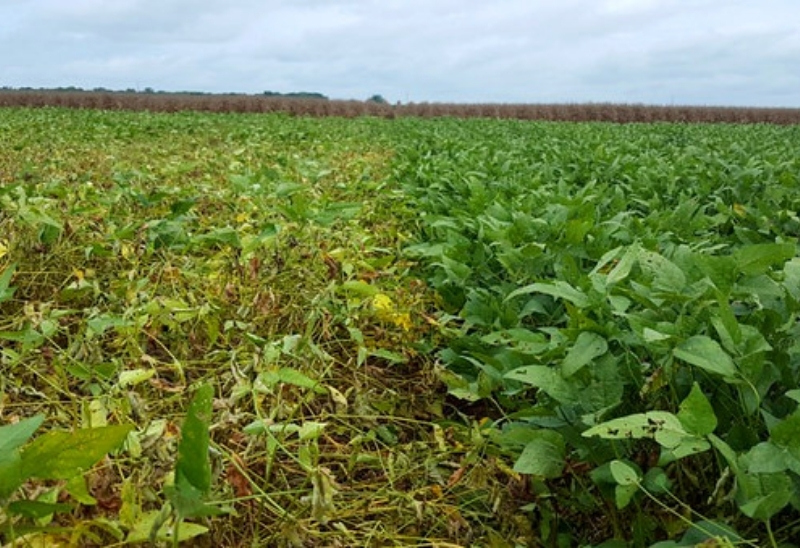 Image courtesy of the Arkansas Agricultural Experiment Station on Flickr
Image courtesy of the Arkansas Agricultural Experiment Station on Flickr
Crop Rotation Reduces Inputs & Expenses
Another major benefit of proper crop rotation is avoiding a drop-off in soil fertility and loss of nutrients. A crop you grow one year may leach or use up a significant amount of one nutrient. Following that crop with an alternate one that returns depleted nutrients into the soil reduces the amount of inputs you have to add artificially. Now you are on your way to creating a healthy, sustainable system.
A typical plan for crop rotation includes planting a crop that produces nitrogen (legume) followed by a crop that utilizes nitrogen (most others).
Sample Crop Rotation Plans For Food Plots
Time to create a game plan. Let’s say your notes show that last year you planted a brassica mix, like our Prime Time Brassica Blend. (You did take notes last year, right?) These brassica varieties used a significant amount of nitrogen and phosphorus and may have consumed other micronutrients. Don't repeat the cycle -- soil test to determine which nutrients need replenishment. Then consider a cereal crop or winter legume (or a combination!) this season.
What about next year, after you've grown a perennial clover mix or alfalfa? When these legume crops are starting to wane, you can return to planting a heavy nitrogen-consuming crop such as grains or brassicas - whichever you planted longest ago.
While you can add organic or synthetic nitrogen fertilizer, why not let nature do the work? Properly inoculated legumes, like our Aberlasting White Clover, fix nitrogen from the air in root nodules that slowly release through decay in the soil. Depending on your soil test recommendations, legumes may not provide 100% of your nitrogen need, but it will certainly help save some time and money!
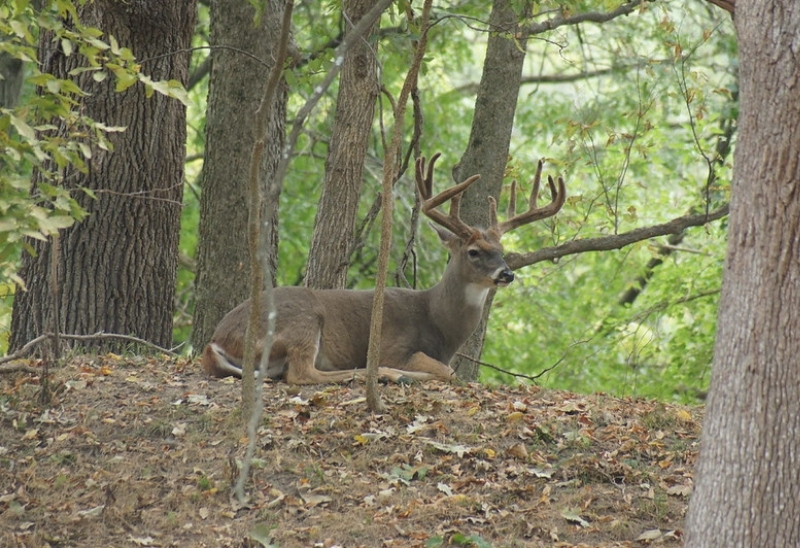 Image courtesy of David Williss on Flickr
Image courtesy of David Williss on Flickr
Next Up: Weed Management
In article 4 of our “Food Plots for Pros” series, we’ll cover the common, but pesky, weeds you may encounter in your food plots. We will discuss how to address all types of weeds through herbicide and other management techniques.
Deer Creek Seed is your resource for soil evaluation, food plot planning, and premium forage seed. Let us help you create a wildlife buffet for all seasons. Improving soils to benefit wildlife is a cumulative process that takes time but pays big rewards. There’s no time like today to start! Let us know how we can help make your food plots outperform your neighbor’s.
Additional Resources
- For southern food plot planters, the University of Tennessee Extension offers a Landowners’ Guide to Wildlife Food Plots that covers many crops suited to wildlife species.
- The University of Georgia has a great cool-season wildlife food plot article.
- Planting for summer feed? The National Deer Association’s Guide to Summer Food Plots has a great profile on heat-loving crops.
- Enhancing White-Tailed Deer Habitats on Your Property by the University of Missouri Extension
- Food Plots for Wildlife by the USDA National Resource Conservation Service Iowa provides good seeding rate information along with recommended locations for various crops relative to other land features.



